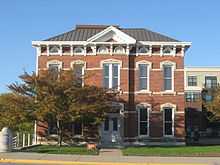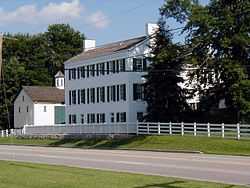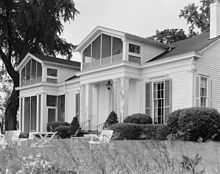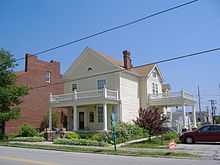Indiana Landmarks



Indiana Landmarks is America's largest private statewide historic preservation organization. Founded as the Historic Landmarks Foundation of Indiana by Indianapolis pharmaceutical executive Eli Lilly in 1960, the organization is a private non-governmental organization with nearly 11,000 members and an endowment of over $40-million.[1] The organization simplified its name to Indiana Landmarks in 2010.
The organization has staff housed in regional offices throughout the state of Indiana and owns two museum properties: the Morris-Butler House in Indianapolis and the Huddleston Farmhouse Inn Museum in Cambridge City, Indiana. Regional offices are located in South Bend, Hobart, Wabash, Jeffersonville, Aurora, Evansville, Cambridge City and Terre Haute. Its state headquarters is at the former Central Avenue Methodist Church in Indianapolis. Landmarks' honorary board chair is Indiana's former Chief Justice Randall T. Shepard.[1]

One of Landmarks' largest projects was the $30-million+ restoration of the West Baden Springs Hotel's exterior and public spaces. Indiana Landmarks helped lead the effort to bring riverboat gaming to Orange County, Indiana as a way to revitalize the French Lick Resort Casino and the West Baden Springs Hotel.
New name, headquarters
On April 13, 2010, Indiana Landmarks announced its name change from Historic Landmarks Foundation of Indiana. At the same time, it announced that medical device entrepreneur Bill Cook and his wife, Gayle have pledged $7-million to renovate the former Central Avenue Methodist Church at 12th Street and Central Avenue in the Old Northside Historic District of Indianapolis as a performance space and new headquarters for the organization to be known as Indiana Landmarks Center.
Endangered Landmarks
Annually, Indiana Landmarks selects the 10 Most Endangered landmarks. They may be at risk because they have been abandoned, neglected, quickly deteriorating, and or at risk of destruction from urban sprawl. When Landmarks places a structure on its list, it will spend the next year in a concerted effort to improve the structures status and rescue it from neglect. Each year the list will retain those structures still at risk, added structures that have worsened and remove those that have improved.[2]
2012 Ten Most Endangered List
- Old Clarksville Site, Clarksville
- Harmony Way Bridge, New Harmony
- The American House, Centerville
- The Pantheon, Vincennes
- Masonic Temple, Jeffersonville
- Sylvan Springs, Rome City: continuing since 2011
- House of Tomorrow, Indiana Dunes National Lakeshore
- Wilkinson House, Muncie
- Tyson Auditorium, Versailles
- Taggart Memorial, Riverside Park, Indianapolis: continuing since 2011
2011 Ten Most Endangered List[3]
- Farmers Institute, southwest of Lafayette: continuing since 2010
- George DeBaptiste House, Madison
- Downtown Greenwood, Johnson County
- Haven Hubbard Home, New Carlisle
- Historic windows, statewide: continuing since 2009
- Roberts Memorial Building, Connersville: continuing since 2010
- St. John’s Hospital, Gary: continuing since 2010
- Sylvan Springs, Rome City
- Taggart Memorial, Riverside Park, Indianapolis
2010 Ten Most Endangered List[4]
- Bush Stadium, Indianapolis: continuing since 2008
- Farmers Institute, southwest of Lafayette
- Historic windows, statewide: continuing since 2009
- Plainfield Diner, Plainfield
- Roberts Memorial Building, Connersville
- St. John’s Hospital, Gary
- Syracuse Depot, Syracuse: continuing since 2008
- Terrell Jacobs Circus Barns, Peru: continuing since 2009
- Washington Avenue Historic District, Evansville (Vanderburgh County): continuing since 2007
- John Work House, Charlestown vicinity
2009 Ten Most Endangered List[2]
- Bush Stadium, Indianapolis (Marion County); added in 2008
- Historic windows, statewide: new in 2009
- Knightstown Children's Home, near Knightstown (northern Rush County); added in 2009
- Maple Grove Road Rural Historic District, Bloomington (Monroe County): added in 2008
- Old Lowell Grade School, Lowell (Lake County): added in 2008
- Old Perry County Courthouse, Rome (Perry County): new in 2009
- Snow Hill Covered Bridge, near Rockdale (Franklin County): new in 2009
- Syracuse Depot, Syracuse (Kosciusko County): since 2008
- Terrell Jacobs Circus Barns, Peru (Miami County): new in 2009
- Washington Avenue Historic District, Evansville (Vanderburgh County): continuing since 2007
2007 Ten Most Endangered List:[5]
- Colgate Palmolive Plant and Clock, Clarksville (Clark County)
- Frankfort Roundhouse, Frankfort (Clinton County)
- Illinois Building, Indianapolis (Marion County)
- Indianapolis Public School #97 (James E. Roberts School) Indianapolis (Marion County)
- Jennings Building, New Castle (Henry County)
- Marktown Historic District, East Chicago (Lake County)
- Twin Bays, Lawrenceburg (Dearborn County)
- Washington Avenue Historic District, Evansville (Vanderburgh County)
- Whitley County Jail & Sheriff's House, Columbia City (Whitley County)
- Wollenmann House, Ferdinand (Dubois County)
References
- ↑ 1.0 1.1 The Encyclopedia of Indianapolis By David J. Bodenhamer, Robert Graham Barrows, David Gordon Vanderstel, pg 685
- ↑ 2.0 2.1
- ↑ "Ind. Landmarks announces state's 10 Most Endangered". Indiana *Landmarks. May 2, 2011. Retrieved July 6, 2012.
- ↑ "Local News | 93.1 WIBC". Wibc.com. Retrieved 2014-08-21.
- ↑ 4/17/2008 (2008-04-17). "Inside Indiana Business". Inside Indiana Business. Retrieved 2014-08-21.
Further reading
- The Encyclopedia of Indianapolis David J. Bodenhamer, Robert Graham Barrows, David Gordon Vanderstel,
- Porter County Interim Report, Indiana Historic Sites and Structures Inventory; Historic Landmarks Foundation of Indiana; July 1991
External links
| Wikimedia Commons has media related to Landmarks in Indiana. |